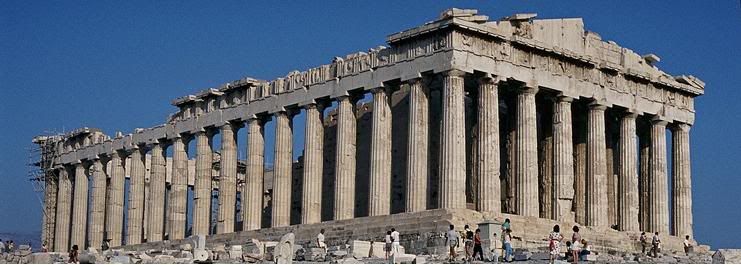main |
sidebar
 The Parthenon: considered to be the greatest building ever built on ancient times. It sits on top of the Acropolis in Greece. Acropolis means:"...the fortified height or citadel of an ancient Greek city; ... a raised area holding a building or cluster of buildings." another name given to it is: Sacred Rock ,so named due to the fact that it was used continuously as a place for cult ceremonies and also as residence or even both at some point in time. The Parthenon is one of the magnificent monuments dedicated to Athena Parthenos- the patron goddess of Athens. Inscriptions showed that these structures were built roughly around 447 to 438 B.C. Today, time took its toll for the roof has almost completely collapsed,thanks to the preservationists who are doing great efforts for its restoration.
The Parthenon: considered to be the greatest building ever built on ancient times. It sits on top of the Acropolis in Greece. Acropolis means:"...the fortified height or citadel of an ancient Greek city; ... a raised area holding a building or cluster of buildings." another name given to it is: Sacred Rock ,so named due to the fact that it was used continuously as a place for cult ceremonies and also as residence or even both at some point in time. The Parthenon is one of the magnificent monuments dedicated to Athena Parthenos- the patron goddess of Athens. Inscriptions showed that these structures were built roughly around 447 to 438 B.C. Today, time took its toll for the roof has almost completely collapsed,thanks to the preservationists who are doing great efforts for its restoration.
 One very important aspect that I learned from the study of these monuments is that special design technique used initially by the Egyptians but adopted later by the Greeks during those golden years is :Entasis.
One very important aspect that I learned from the study of these monuments is that special design technique used initially by the Egyptians but adopted later by the Greeks during those golden years is :Entasis.

Monday, April 04, 2005
History is quite a delicate topic for discussion because it involves what went through where,dealing with dates and true events. I'm not @ all sure when it all began. But one thing is certain, it (history) has gone too many paths and left more than enough memories and embedded a special place in our minds for us to reminisce with hopes of bringing back those golden days gone by.
Over the years of my studies in the field of Architecture, I came about too many structures too soon for me to decipher and digest. It wasn't until recently that I realize they were all too good to be forgotten. We get to learn more of the structures which I thought to be insignificant. But I was proven wrong. The structures of the old days are the basis of construction of today. The method they used then might not be the exact ways we currently deploy but mind you only tiny innovations are added. For example: Binding together chunks of stones used to be done with dried straws of fibrous materials found near the river Nile like wheat mixed with mud, yolks of egg and limestone. Today after cement- which is a mixture of: clay and powdered limestone but burned to a very high degree inside a furnace- was invented in Leeds, England by Joseph Aspdin in 1824, the bonding technique has evolved into what we call now as "concrete".
 The Parthenon: considered to be the greatest building ever built on ancient times. It sits on top of the Acropolis in Greece. Acropolis means:"...the fortified height or citadel of an ancient Greek city; ... a raised area holding a building or cluster of buildings." another name given to it is: Sacred Rock ,so named due to the fact that it was used continuously as a place for cult ceremonies and also as residence or even both at some point in time. The Parthenon is one of the magnificent monuments dedicated to Athena Parthenos- the patron goddess of Athens. Inscriptions showed that these structures were built roughly around 447 to 438 B.C. Today, time took its toll for the roof has almost completely collapsed,thanks to the preservationists who are doing great efforts for its restoration.
The Parthenon: considered to be the greatest building ever built on ancient times. It sits on top of the Acropolis in Greece. Acropolis means:"...the fortified height or citadel of an ancient Greek city; ... a raised area holding a building or cluster of buildings." another name given to it is: Sacred Rock ,so named due to the fact that it was used continuously as a place for cult ceremonies and also as residence or even both at some point in time. The Parthenon is one of the magnificent monuments dedicated to Athena Parthenos- the patron goddess of Athens. Inscriptions showed that these structures were built roughly around 447 to 438 B.C. Today, time took its toll for the roof has almost completely collapsed,thanks to the preservationists who are doing great efforts for its restoration.  One very important aspect that I learned from the study of these monuments is that special design technique used initially by the Egyptians but adopted later by the Greeks during those golden years is :Entasis.
One very important aspect that I learned from the study of these monuments is that special design technique used initially by the Egyptians but adopted later by the Greeks during those golden years is :Entasis. You see when columns are placed side by side with each other, they create an optical illusion of curving inwards as the height increases, so what they did was make the shaft (middle part) of the columns bigger thus creating the opposite optical illusion of curving outwards giving the impression of being straight up to the tip. The point is:"... to give the appearance of straight lines through the use of curves and optical illusion." Isn't that ingenious! (The framed object is the Parthenon)
-------------------------------
Studies of monuments like these are just one of the many important subjects taught in History of Architecture which I find very interesting and relevant in my day to day existence and in my tasks as a lady Architect.
2 Comments:
-
- Anonymous said...
5:17 AM, April 05, 2005hello. ur blog has greatly improved. keep up the good work. i like your musings on architecture.- Ms.B said...
9:38 AM, April 05, 2005thanks Stephen for visiting...i'm trying.
Subscribe to:
Post Comments (Atom)
About Ms. B

- Ms.B
- Hi! your friendly neighbor Architect who loves ART eternaly... and poetry is my PASSION!
Pure thoughts, longed emotions, prayers and cherished dreams inside my heart chronicled here as time flew swiftly by...


